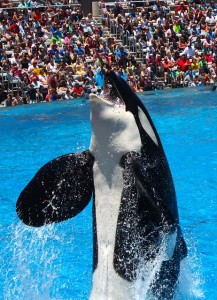
SAN ANTONIO – A new peer-reviewed study published in the Journal of Mammalogy by the Oxford University Press adds important insights to the debate over how long killer whales in human care live. The study found no difference in life expectancy between killer whales born at SeaWorld and a well-studied population of wild killer whales.
The study, “Comparisons of life-history parameters between free-ranging and captive killer whale (Orcinus orca) populations for application toward species management,” compares current published data for survival and reproductive activity of known-age Pacific Northwest killer whales since 1975 with the life history of killer whales in SeaWorld’s care. The average life expectancy for SeaWorld’s killer whales is 41.6 years; average life expectancies for Southern and Northern Resident killer whales are 29.0 and 42.3 years respectively.
Additionally, the study shows that average calf survival rate from approximately 6 months of age (i.e., age at first sighting) to age 2 in the Southern Resident killer whale population (79.9 percent) is significantly less than SeaWorld’s average calf survival rate from 40 days to age 2 (96.6 percent). The study may be accessed and read in full by following this link: http://jmammal.oxfordjournals.org/content/early/2015/07/09/jmammal.gyv113.article-info
“Although emotion will always be a part of the debate as to whether killer whales, or any other species, should be maintained in human care, it is absolutely necessary to have validated facts when an argument for or against is being made on scientific grounds,” said study author Kevin Willis, Vice President for Biological Programs for the Minnesota Zoo. “Based on the available data, it is now clear that it cannot be truthfully argued that killer whales should not be maintained in captivity because they have a shortened life expectancy relative to their wild counterparts.”
The objective of this study was to characterize and compare reproductive parameters and survivorship patterns of free-ranging killer whales in the Pacific Northwest and killer whales living at SeaWorld using methodologies previously published for zoological and free-ranging populations. The Northern and Southern Resident killer whale populations of the Pacific Northwest are the most studied and documented wild killer whales in the world. These new comparisons provide a novel metric from which comparisons with other populations can be made. They also shed new light on age estimates for the species as a whole.
“This article represents the first peer-reviewed publication that directly compares reproductive and survivorship patterns between captive and wild killer whales,” said study author Todd Robeck, DVM, Ph.D., Vice President of Theriogenology for SeaWorld Parks & Entertainment.
“The results demonstrate unequivocally that killer whales in captivity have similar life expectancies to those in the wild and provide invaluable knowledge concerning normal reproductive patterns of this species. This information is imperative for developing management plans and directing future research efforts that are designed to protect wild killer whale populations.”
The ability to study killer whales in controlled research settings in accredited zoological institutions like SeaWorld has provided most of the fundamental information known about the species’ physiology including adaptations to diving; auditory detection, echolocation, and learning; reproductive physiology; growth and development; metabolic and energy requirements; and immune system function.









Credibility Alert! Credibility Alert! The authors of this study are three SeaWorld employees and another who works at a zoo. The average age of the orcas who have died at SeaWorld is 13 years, and only one orca at SeaWorld—Corky, who was captured in the wild—has actually reached SeaWorld’s claimed “average life expectancy” of 41.6 years. Every single orca who has perished at SeaWorld died far short of how long they are expected to live, though it is in fact hard to call it “living” when their “life” consists of being forced to perform circus-style tricks in a tiny concrete tank. A recent INDEPENDENT study shows significantly lower average orca longevity in captivity. SeaWorld’s claims simply don’t hold water.
Thank you for sharing those insights and info. Feel free to link the independent study here.
Here is a link to the independent study:
http://onlinelibrary.wiley.com/doi/10.1111/mms.12225/abstract
Thank you Jennifer – now everyone has access to opposing views and can choose for themselves. Appreciate you following up!
Rubbish. The Seaworld funded study (also authored by SeaWorld, and not by anyone at Oxford) claims that SeaWorld orcas live about 41.6 years, but a real peer-reviewed study recently published by Marine Mammal Science concluded that the life expectancy of captive whales is only 11.8 years. SeaWorld “research is biased and laughable, I’m expecting the Journal of Mammalogy to retract the study, after the paper’s severely flawed methodology and fuzzy math is scrutinized.
http://onlinelibrary.wiley.com/doi/10.1111/mms.12225/full
So sick of churnalism like this …. copying and pasting press releases from companies is not “NEWS”.
The info is available and shared and when others responded that info was shared as well. Feel free to share your info if you choose.